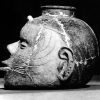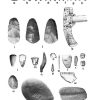calsfoundation@cals.org
Battle Mound Site
The Battle Mound site is a Caddo site located along the Red River in Lafayette County. The Red River landscape is an ecologically diverse region with numerous channel scars, oxbow lakes, and back swamps. With agriculturally productive soil deposits and a web of linked navigable waterways, the region has numerous prehistoric and historic archaeological sites, many being sites left by the ancestors of the Caddo Indians who lived in this area from at least as early as circa AD 900 and as late as the early nineteenth century.
The most prominent feature at Battle Mound is a large north-south-aligned earthen mound with at least three platforms. The mound is the largest in the Caddo area and one of the largest in the southeastern United States, with dimensions of 200 meters (656 feet) in length by 90 meters (295 feet) in width, with a maximum height of 9.6 meters (31 feet). Two very low rises (0.5–1 meter in height) are discernible directly east of the mound. Additionally, two borrow pits are visible on the landscape. A large borrow pit is located north of the mound, and a second smaller borrow pit is directly west of the mound.
In addition to the long history of Caddo residency, the region also has a history of Euro-American settlement. For example, the name given to the site does not represent the location of a conflict or conflagration but rather comes from the Battle family. James J. Battle was from North Carolina and moved his family westward, finally settling in Lafayette County in 1844. He eventually owned the land at what is today the Battle Mound site.
Although considered significant in several archaeological and cultural aspects, this monumental Caddo mound center has seen few systematic archaeological investigations. The earliest recorded work is by Clarence B. Moore during his five months on the Red River between 1911 and 1912. Moore navigated his steamboat, The Gopher, up and down the Red River to record and excavate several mound sites, including Battle Mound.
After the Moore investigations, sporadic but intense (now illegal) looting at and around the site took place. The hundreds of exquisitely crafted ceramic vessels and other artifacts removed during these collection efforts were used to enhance museum and private collections throughout North America. For example, numerous vessels became part of the Judge Harry J. Lemley Collection and are now housed at the Gilcrease Museum in Tulsa, Oklahoma. A recent analysis of a small portion of the Lemley Collection documents several vessels that are associated with Haley (AD 1200–1500) and Belcher (AD 1500–1700) phase occupations.
In 1948, research into the construction of the mound was headed by Dr. Alex D. Krieger of the University of Texas and supervised by Lynn E. Howard from the University of Michigan. The 1948 investigations constitute the only systematic excavations wherein several trenches were dug on both the north and south mound platforms. At least three circular Caddo structures dated to the fifteenth century AD were discovered. Excavations indicate that structures on the south platform were associated with communal and feasting activities, whereas structures on the north platform were associated with domestic use.
Beginning in 1979, and continuing intermittently until 1991, the Arkansas Archeological Survey Research Station at Southern Arkansas University (AAS–SAU) in Magnolia (Columbia County) began a program of artifact surface collection. Areas were delineated based on the presence of topographic features, knowledge of previous archaeology at the site, and selection of locations immediately proximate to the mound. Surface collection artifacts document a significant period of prehistoric occupation ranging from at least the Archaic Period, through the Woodland Period, and into the Caddo time period. The surface collection is housed at AAS–SAU and represents the first systematic recording of off-mound occupations at the site.
The most recent research has continued to investigate the landscape surrounding the mound where a large-area geophysical survey has been conducted. Results reveal numerous geophysical anomalies that document off-mound activity of both historic and Caddo occupations. In particular, results document the presence of numerous circular anomalies interpreted as the remains of Caddo structures.
The site and the surrounding area are significant to the Caddo people and to archaeologists, based on an interest in documenting and developing a broader understanding of the occupational history of the Caddo Indians in the Red River region. To the Caddo people, the Battle Mound site represents a tangible piece of the landscape that serves to reconnect them with their past.
For additional information:
Bolton, Herbert Eugene. The Hasinais: Southern Caddoans as Seen by the Earliest Europeans. Norman: University of Oklahoma Press, 1987.
Girard, Jeffrey S., Timothy K. Perttula, and Mary Beth Trubitt. Caddo Connections: Cultural Interactions Within and Beyond the Caddo World. Lanham, MD: Rowman & Littlefield, 2014.
McKinnon, Duncan P. The Battle Mound Landscape: Exploring Space, Place, and History of a Red River Caddo Community in Southwest Arkansas. Research Series 68. Fayetteville: Arkansas Archeological Survey, 2017.
Moore, Clarence B. “Some Aboriginal Sites on the Red River.” Journal of Academy of Natural Sciences of Philadelphia 14 (1912): 481–638.
Perttula, Timothy K. “The Caddo Nation”: Archaeological and Ethnohistoric Perspectives. Austin: University of Texas Press, 1992.
Perttula, Timothy K., Bo Nelson, Mark Walters, Robert Cast, and Bobby Gonzalez. Documentation of Caddo Funerary Objects in the Gilcrease Museum Collections. Special Publication No. 12. Austin: Friends of Northeast Texas Archaeology, 2009.
Perttula, Timothy K., and Chester P. Walker, eds. The Archaeology of the Caddo. Lincoln: University of Nebraska Press, 2012.
Duncan P. McKinnon
University of Central Arkansas
 Historic Preservation
Historic Preservation Native American Pottery
Native American Pottery Pre-European Exploration, Prehistory through 1540
Pre-European Exploration, Prehistory through 1540 Battle Mound Site
Battle Mound Site 




Comments
No comments on this entry yet.